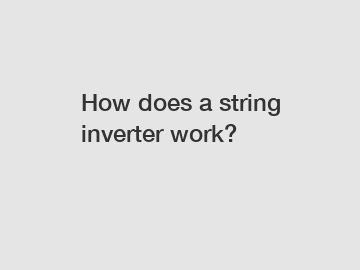Dec. 15, 2023
Energy
Welcome to our blog where we unravel the intricacies of solar energy systems! Today, we delve into the fascinating world of string inverters, the backbone of any solar power setup. Whether you're a solar enthusiast, engineer, or simply curious, this article will shed light on how these devices efficiently convert DC solar energy into usable AC power.
Chapter 1: Understanding the Basics.
To start, let's discuss the fundamental components of a string inverter system. At its core, a string inverter receives power from multiple solar panels, usually connected in series-parallel strings. The direct current (DC) generated by these panels is then transformed into alternating current (AC) suitable for home and commercial consumption.

Chapter 2: MPPT Technology.
One critical aspect of the string inverter is its Maximum Power Point Tracking (MPPT) technology. This intelligent feature allows the device to optimize power output based on varying solar conditions, enhancing overall efficiency. By continuously monitoring and adjusting the voltage and current levels, MPPT ensures the inverter is consistently operating at the maximum power point of the solar array.
Chapter 3: Conversion Process.
Now, let's dive into the intriguing conversion process that takes place within a string inverter. As the DC power enters the inverter, it encounters an array of electronic components meticulously designed to perform the necessary conversions. Here, we explore the three primary stages involved:
Stage 1: DC to AC Conversion.
The first stage involves converting the DC power into AC power. Various control circuits and switches within the inverter control the flow of DC power, transforming it into a usable alternating current. This AC power output conforms to the electrical standards of the grid or the connected load.
Stage 2: Voltage Transformation.
Further reading:Once converted to AC, the voltage level is adjusted to match the necessary output. Consequently, the output voltage of the string inverter is usually adjusted to the voltage required by the grid or electrical system, ensuring seamless power transmission.
Stage 3: Synchronization with the Grid.
In the final stage, the AC output of the string inverter is synchronized with the electricity grid. This vital step is essential for safe and reliable transfer of solar energy back to the grid, or for power consumption within the connected load. Through intricate circuitry, the inverter ensures that the AC power it generates is in harmony with the electrical grid's voltage and frequency.
Chapter 4: Safety and Fault Protection Mechanisms.
To guarantee the long-term, reliable operation of a string inverter, numerous safety and fault protection mechanisms are implemented. These measures safeguard the system against various potential risks, including overvoltage, overcurrent, and temperature surges. Moreover, modern string inverters come equipped with built-in ground fault protection to prevent electrical faults, promoting user safety.
Chapter 5: Monitoring and Data Analysis.
Nowadays, string inverters offer comprehensive monitoring and data analysis capabilities. By connecting to a digital interface, users can access valuable information regarding the system's performance, energy production, and other vital parameters. This data helps users identify potential issues, optimize system efficiency, and ensure maximum return on their solar investment.
Conclusion:
As we conclude our exploration of string inverters, we hope you now have a deeper understanding of how these devices efficiently convert solar energy into usable power. With their MPPT technology, conversion stages, safety measures, and comprehensive monitoring capabilities, string inverters are critical in making solar energy accessible and reliable.
Remember, when considering a solar power system, consult experienced professionals who can guide you in selecting the right string inverter for your specific requirements. Embrace the power of the sun and help build a sustainable future!
If you are looking for more details, kindly visit low voltage lithium battery for marine applications, residential ac-coupled inverter, Safety features hybrid storage inverter.
Further reading:Related Articles
If you are interested in sending in a Guest Blogger Submission,welcome to write for us!
All Comments ( 0 )